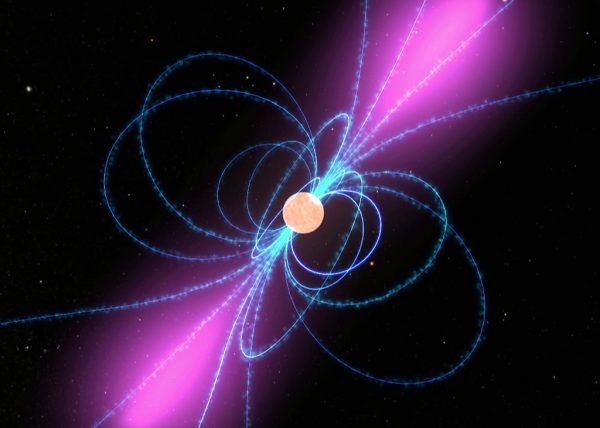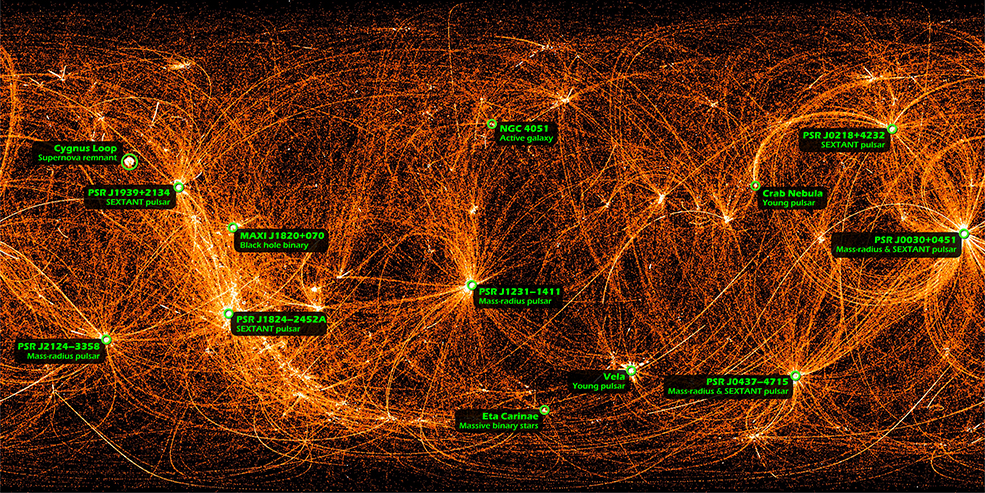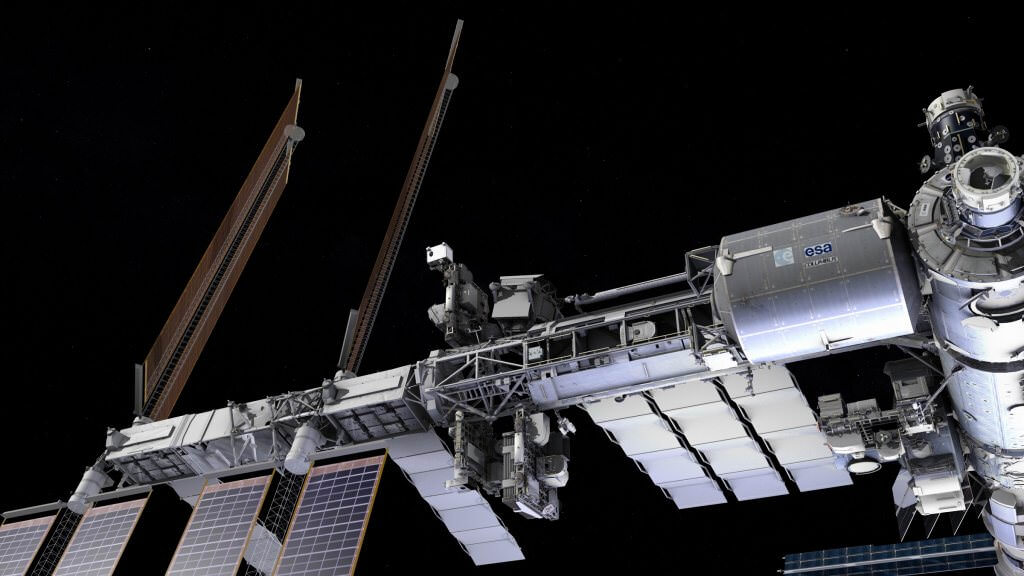Astronomers Map the Surface of a Pulsar – Universe Today
When stars exhaust their supply of fuel, they collapse under their own weight and explode, blowing off their outer layers in an event known as a “supernova”. In some cases, these events leave behind neutron stars, the smallest and densest of stellar objects (with the exception of certain theoretical stars) that sometimes spin rapidly. Pulsars, a class of neutron star, can spin up to several hundred times per second.
One such object, designated J0030+0451 (J0030), is located about 1,100 light-years from Earth in the Pisces constellation. Recently, scientists using NASA’s Neutron star Interior Composition Explorer (NICER) were able to measure the pulsar’s size and mass. In the process, they also managed to locate the various “hot spots” on its surface, effectively creating the first map of a neutron star.
Since 2017, NICER has been conducting observations from the International Space Station (ISS) for the purpose of creating of learning what goes on inside a neutron star. In addition to providing high-precision measurements of neutron stars and other super-dense objects, the data it collects will also be used to create an X-ray map of the cosmos and to test pulsars as a possible navigation beacon.
As Paul Hertz, the director of NASA’s astrophysics division, said in a recent NASA press release:
“From its perch on the space station, NICER is revolutionizing our understanding of pulsars. Pulsars were discovered more than 50 years ago as beacons of stars that have collapsed into dense cores, behaving unlike anything we see on Earth. With NICER we can probe the nature of these dense remnants in ways that seemed impossible until now.”
For decades, scientists have been studying pulsars in the hopes of getting a better understanding of their inner workings. According to the simplest model, pulsars have incredibly powerful magnetic fields shaped like a dipole magnet. Combined with the pulsar’s rotation, this causes particles from its surface to be focused into tight beams emitted from the poles. This creates a strong strobing effect that resembles a lighthouse to observers.
This effect leads to variations in the pulsar’s brightness (in the X-ray wavelength), which astronomers have observed in the past. At the same time, astronomers have also observed hotspots on the surface of pulsars, which are the result of their magnetic fields ripping particles from the surface and accreting them around the poles. While the entire surface glows brightly in X-rays, these hot spots glow brighter.
However, the new NICER studies of J0030 (a millisecond pulsar that revolves 205 times per second) showed that pulsars aren’t that simple. Using NICER data obtained from July 2017 to December 2018, two groups of scientists mapped out the hotspots on J0030 and came to similar conclusions about its mass and size.

The first team was led by Thomas Riley and his supervisor Anna Watts, a doctoral student in computational astrophysics and a professor of astrophysics (respectively) at the University of Amsterdam. To recreate the X-ray signals they observed, Riley and his colleagues conducted simulations of overlapping circles of different sizes and temperatures using the Dutch national supercomputer Cartesius.
In addition to determining that J0030 is around 1.3 Solar masses and 25.4 km (15.8 mi) wide, they identified two hot spots – one small and circular, the other long and crescent-shaped. The second team, led by astronomy professor Cole Miller of the University of Maryland, conducted similar simulations using UMD’s Deepthought2 supercomputer.
They found that J0030 is 1.4 Solar masses, measures 26 km (16.2 mi) wide, and came up with two solutions for hotspots. In the first, they identified two possible hotspots, one of which has two ovals that closely matches the results of Riley’s team. In the second, they found a possible third hotspot located around the pulsar’s southern rotational pole.
As Riley explained, these results revealed a great deal about J0030 and other pulsars:
“When we first started working on J0030, our understanding of how to simulate pulsars was incomplete, and it still is. But thanks to NICER’s detailed data, open-source tools, high-performance computers and great teamwork, we now have a framework for developing more realistic models of these objects.”

As predicted by Einstein’s General Theory of Relativity, a pulsar is so dense that its gravity warps the very fabric of space-time around it. The effect is so pronounced that light coming from the side facing away from the observer is bent and redirected towards them. This makes the star look bigger than it really is and means that hot spots don’t disappear entirely when they rotate away from the observer.
Thanks to NICER’s precision, which is about 20 times that of previous instruments, astronomers are able to measure the arrival of each X-ray from a pulsar to better than a hundred nanoseconds. From Earth, the two teams had a clear view of J0030’s northern hemisphere and expected to find one hotspot there. Instead, they identified up to three, all of which were located in the southern hemisphere.
As Miller explained, these observations would not have been possible without NICER’s precision:
“NICER’s unparalleled X-ray measurements allowed us to make the most precise and reliable calculations of a pulsar’s size to date, with an uncertainty of less than 10%. The whole NICER team has made an important contribution to fundamental physics that is impossible to probe in terrestrial laboratories.”
This constitutes the first case of astronomers mapping out the surface of a pulsar, and the results indicate that their magnetic fields are more complicated than the traditional dipole model would suggest. While scientists have yet to determine why J0030’s spots are arranged and shaped the way they are, these findings indicate that these answers could be within reach.

Even more impressive is the fact that two teams arrived at similar findings independently of one another. As Zaven Arzoumanian, the NICER science lead at NASA’s Goddard Space Flight Center, expressed:
“It’s remarkable, and also very reassuring, that the two teams achieved such similar sizes, masses and hot spot patterns for J0030 using different modeling approaches. It tells us NICER is on the right path to help us answer an enduring question in astrophysics: What form does matter take in the ultra-dense cores of neutron stars?”
As part of the Astrophysics Mission of Opportunity element of NASA’s Explorers program, NICER’s main scientific objective is to precisely measure the size and mass of several pulsars. This information will yield valuable clues as to what transpires within their interiors, where matter is compressed to densities that are impossible to simulate in laboratories here on Earth.
This information will also help advance astronomers’ understanding of black holes and other super-dense objects. The analysis of the NICER observations of J0030 has already led to a series of papers that are featured in a focus issue of The Astrophysical Journal Letters.
Be sure to check out this video that explains the researchers’ findings as well, courtesy of the NASA Goddard:
Further Reading: NASA





